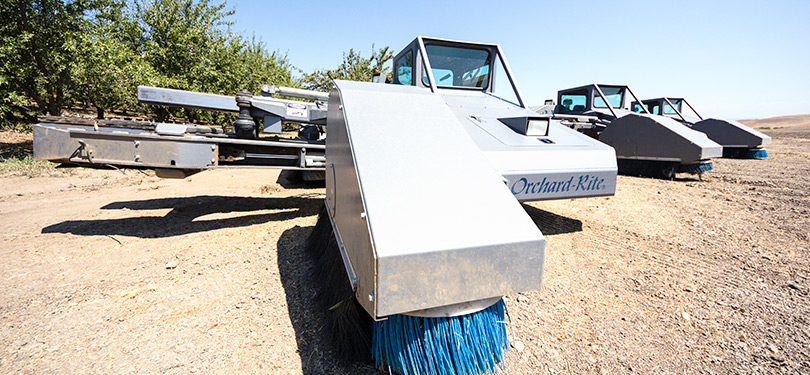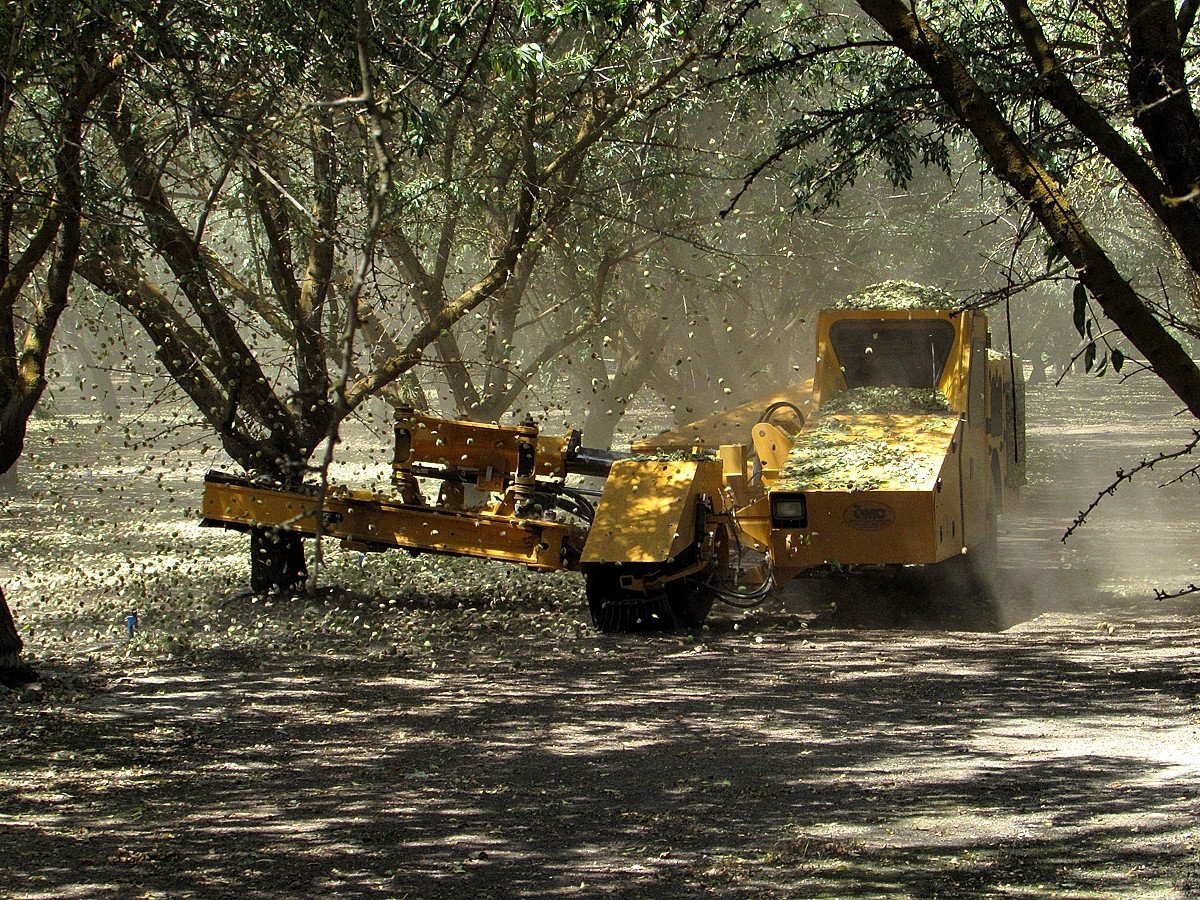- August 9, 2016
- By resadmin
- In Uncategorized
- 1068
- 0

Orchard Shakers – Stanislaus sees huge increase in almond orchards as demand soars
|
||
| Orchard Shakers – Millions of newly planted almond trees are transforming Stanislaus County, Modesto, Ceres, Hughson, Oakdale, Patterson, Riverbank, Salida — economically, environmentally, aesthetically and maybe even culturally.
More than 18 million trees now produce those tasty little nuts in the county, and the world’s population can’t seem to get enough of them. Almond products emerged as the county’s most valuable crop last year, and it is expected to dominate the agriculture industry for years to come. That’s because almond acreage is soaring throughout the county. Harvested acres increased by nearly 60 percent in six years, and thousands of acres of young trees will start bearing fruit in the next couple of seasons. About 1 in 6 acres of Stanislaus County land now is growing almonds, and more orchards are planned. Almond meats, hulls and shells from trees in the county generated a record-breaking $786.9 million in sales during 2012. Almond products edged out the county’s dairy proceeds, which dipped to $739.6 million last year. Dream crop Now here’s the surprising thing: It’s mostly small orchards — not big corporate farmers — growing almonds. “The beauty about almonds is it can be a family operation” because orchards require relatively little labor compared with most other crops, explained Roger Duncan, the University of California’s farm adviser in Stanislaus County, who specializes in almonds. The county has 1,223 almond growers running 1,600 orchards, according to registered pesticide user records. Last year, they produced 338 million pounds of almond meat. Most of those nuts were shipped abroad to Asia and Europe, which helped make almonds California’s top export. While some of Stanislaus County’s biggest growers control more than 7,000 acres, Duncan said part-time farmers working less than 50 acres are the norm. Stanislaus County has “the largest concentration of family almond farms in the state,” according to Duncan. He said many people with full-time city jobs work their own 20- to 40-acre orchards on the side. “As trees go, almonds are pretty simple,” Duncan said. “Harvesting is heavily mechanized, and it doesn’t require a lot of labor.” That’s why guys like Oakdale’s Dan Ciarolla and his father, Joe, can pretty much run a 43-acre orchard on their own. With an operation that size, “you can make a decent living and go on vacation once in a while,” said Ciarolla, whose family bought the orchard in 1989. Ciarolla hires someone to shake his 5,500 trees at harvest time and another company to spray pesticides. But he does most everything else, including pruning limbs, sweeping up nuts and mowing down weeds. Often that means working 10-hour days, six days a week, but he’s happy for the work. Before the county’s building industry collapsed, Ciarolla was a general contractor. He took charge of his father’s orchard in 2008 when construction work dried up. “I made more money in construction, but I make a living doing this now,” Ciarolla said. Growing global appetite The nice thing for almond growers recently has been buyers competing for their crops. Worldwide demand for almonds has been strong, so nut prices have remained high despite California’s increasing production. But Ciarolla wonders how long that can last, considering the millions of new trees that have been planted in Stanislaus County alone. “Ten years from now (when most of the new trees hit peak production), I’ll be amazed if the prices are the same,” Ciarolla said. “It’s going to all come to a head, and there are going to be too many almonds.” Jake Wenger has heard that concern before. The fourth-generation Stanislaus farmer said that when California topped 1 billion pounds of almonds a decade ago, people predicted prices would plummet. Business booming for nurseries Now the state produces more than 2 billion pounds per year, and Wenger said prices have stayed lucrative. “New markets have opened up,” said Wenger, who has 150 acres of almonds near Modesto. “Almonds are the most nutrition-rich of all the nuts,” they’re high in protein, stay fresh a long time without refrigeration and get used many ways, including as a milk-substitute beverage. “The Almond Board has done a really good job marketing the crop, and that’s maintained prices,” said Tom Burchell, president of Burchell Nursery in Oakdale. So even though production is at record highs, there’s global demand for more almonds. That’s helped Burchell sell more than 1 million almond trees each of the past several years, and the nursery already is sold out for next spring’s plantings. It is taking orders for 2015. “The demand has been going up and up for almonds, and we’ve been riding the wave,” Burchell said. He’s not the only one. Duarte Nursery in Hughson sold about 2 million almond trees this year, and it expects to sell 2.5 million to 2.6 million next year. Hickman’s Dave Wilson Nursery is even bigger. “We’ll probably sell close to 5 million almond trees next year,” predicted Dennis Tarry, Dave Wilson’s chief executive officer. “We really can’t keep up with the demand for trees. … We’re sold out for 2014 and about 80 percent sold out for 2015.” Those 8.5 million baby almond trees being grown in area nurseries will be planted throughout California. “We’re putting in a ton of almond trees up and down the Central Valley,” said Tarry, whose nursery employs 350 mostly full-time workers. Many of those trees are destined for orchards in Stanislaus, Merced and San Joaquin counties. Tarry said the recession forced many landowners to hold off on planting almonds during 2007, 2008 and 2009, and they’re still catching up. “In the nursery industry,” Tarry said, “we haven’t experienced anything this dramatic before in the demand for trees.” It’s not just growers and nurseries prospering from almonds. “There’s a ripple effect” from almond production that benefits the region’s entire economy, Burchell said. His nursery, for example, employs 200 people (Duarte has 1,000 mostly part-time workers). Growers hire help for their orchards. Truckers haul nuts to processors, such as Turlock’s new Blue Diamond Growers plant. Shippers send almonds abroad. And on and on. Feeding the world Thanks primarily to India, China and Europe, “demand for almonds continues to increase,” said Jeff Duarte, vice president and director of operations for Duarte Nursery. Earth’s population is growing faster than its food supply, Duarte warned, but almonds are an affordable source of shelf-stable protein that can be shipped long distances without degradation. “There are so few places in the world that can grow almonds,” said Duarte, noting how the nuts need cool winters, dry springs, hot summers, enough water and the right soil. Growing expertise is key Almonds also need growers who know what they’re doing, and Duarte said that’s where Stanislaus County excels. “We’ve got a population here that is world-class at growing almonds because of their know-how, diligence and hard work. We can feed the world,” Duarte assured. “So communities like ours are going to become more important on the global scale.” “Almonds are a good fit for us,” Duncan agreed. “For Stanislaus, almonds are a really bright spot in a world of dreary economic news.” That’s why many former dairies, fruit orchards, row crop fields and cattle ranches are converting to almond trees. “Very few peach growers I talk to plan to stay in peaches,” Duncan noted as an example. It makes economic sense to switch to almonds, Duarte said. “If you have 20 acres or more, you can usually make it pencil out to grow almonds,” Duarte said. Burchell estimated it costs about $1,200 per acre to plant a typical 120-tree almond orchard, including paying about $5 per tree plus what it costs to prepare the land and install a watering system. “Plant an orchard, and it will sustain you for 20 to 25 years,” Burchell said. Challenges ahead That’s assuming there continues to be enough water to support them, and that’s a concern. Unlike row crops that can be allowed to lay fallow during dry years, Duncan said trees must be watered regularly because “an orchard is a big investment that has to be kept alive.” Stanislaus County is criss-crossed with irrigation canals, many of which were built more than a century ago. Those canals, fed by reservoirs that store Sierra runoff, supply relatively cheap water to many farms throughout the county. Many new almond orchards are being planted outside those irrigation districts, however, so they’re relying on groundwater pumps. So many farmers have started pumping that wells in some Stanislaus regions are going dry. “Groundwater is a new issue directly attributable to all the new plantings,” Wenger said. “It’s creating new challenges, and it’s something that needs to be researched and addressed by county officials. … Water is a finite resource … and we can run out of it.” Pumping restrictions could become a political hot potato, warned Tom Orvis, the Stanislaus County Farm Bureau’s governmental affairs director. “The issue is going to blow up pretty quick if we have another dry year,” Orvis predicted. “Water is becoming a limiting factor for growers because you’ve got to have it.” Side benefits But there are environmental upsides to all the new almond orchards. While harvest-time tree shaking certainly causes dust, Duncan is convinced those millions of new trees will improve overall air quality because they’ll serve as year-round windbreaks to defuse dust storms. And unlike in the old days, tree trimmings no longer are burned. So that source of air pollution is gone. Trees also pull carbon dioxide out of the air and return oxygen, which benefits air quality. And Duncan predicted there will be fewer vegetation fires in Stanislaus County’s future, because orchards — unlike open ranges — aren’t susceptible to lightning strike fires. Orchards also cool the atmosphere as their leaves release moisture during hot summer days. They absorb noise and add color to the landscape. “There is a risk of putting all your nuts in one basket, so to speak,” Duncan said. So if the almond market ever collapses, the county could suffer a severe economic blow. But almond advocates are confident global demand will continue. “Too many people today think their food comes from the grocery store,” said Tarry, who believes Stanislaus County should be proud of the nutritious almonds it produces. “We’re blessed to live in this valley. We feed a huge chunk of the world, and we’re producing a crop people need.” For repairs on your shaker visit The Rear End Shop or call 209-869-1234 today! |
||
Bee staff writer J.N. Sbranti can be reached at jnsbranti@modbee.com or (209) 578-2196. Read more here: http://www.modbee.com/2013/07/27/2830730/stanislaus-county-sees-huge increase.html#storylink=cpy |
You must be logged in to post a comment.



